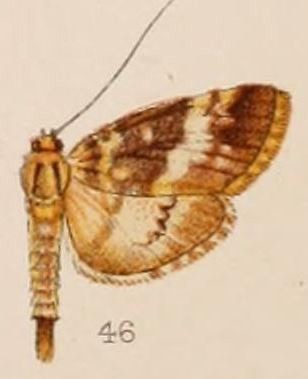
Crambidae comprises the grass moth family of lepidopterans. They are variable in appearance, with the nominal subfamily Crambinae taking up closely folded postures on grass stems where they are inconspicuous, while other subfamilies include brightly coloured and patterned insects that rest in wing-spread attitudes.

Pyraustinae is a large subfamily of the lepidopteran family Crambidae, the crambid snout moths. It currently includes about 1,280 species Most of them tropical but some found in temperate regions including both North America and Europe.

Spilomelinae is a very species-rich subfamily of the lepidopteran family Crambidae, the crambid snout moths. With 4,135 described species in 344 genera worldwide, it is the most speciose group among pyraloids.

Agrotera is a genus of snout moths in the subfamily Spilomelinae of the family Crambidae. It is the type genus of the tribe Agroterini and currently comprises 28 species distributed in the Afrotropical, Palearctic, Indomalayan and Australasian realm.
Argyrarcha is a monotypic moth genus of the family Crambidae described by Eugene G. Munroe in 1974. Its only species, Argyrarcha margarita, described by William Warren in 1892, is found on Madagascar.
Gargela is a genus of moths in the subfamily Crambinae of the family Crambidae. The genus currently comprises 22 Austral-Asian species, of which the majority has been described in recent years. Many species remain to be described, with their total number probably being around 40 species.
Hoploscopa is a genus of snout moths in the subfamily Hoploscopinae of the family Crambidae. The genus was described by Edward Meyrick in 1886, with Hoploscopa astrapias as type species.
Hydropionea is a genus of moths of the family Crambidae. The 13 described species are distributed in Central and South America.

Mnesictena is a genus of snout moths in the subfamily Spilomelinae, where it is placed in the tribe Udeini. The genus was erected by the English entomologist Edward Meyrick in 1884. The currently known seven species are exclusively found on New Zealand and the associated Antipodes Islands and Chatham Islands.

Nagiella is a genus of moths of the family Crambidae. It was established by Eugene G. Munroe in 1964 as a replacement name for NagiaWalker, 1866, a name that was preoccupied by NagiaWalker, 1858 in the Lepidoptera family Erebidae.

Udea is a genus of snout moths in the subfamily Spilomelinae of the family Crambidae. The genus was erected by Achille Guenée in 1845. The currently known 216 species are present on all continents except Antarctica. About 41 species are native to Hawaii.

Lygropia is a genus of snout moths in the subfamily Spilomelinae of the family Crambidae. It currently comprises 66 species, which are mostly found in the tropical and subtropical regions of the Americas, Africa and Asia, but not in Australia.

Placosaris is a genus of snout moths in the subfamily Pyraustinae of the family Crambidae. It is placed in the tribe Pyraustini.
Plantegumia is a genus of moths of the family Crambidae. The three described species are distributed in Central and South America.

Terastia is a genus of snout moths in the subfamily Spilomelinae of the family Crambidae. It was described by Achille Guenée in 1854 with Terastia meticulosalis as type species. The genus is currently placed in the tribe Margaroniini, where it is closely related to the genera Agathodes and Liopasia.

Midilinae is a subfamily of the lepidopteran family Crambidae. It was described by Eugene G. Munroe in 1958. The 11 genera altogether comprise 59 species, with the majority of them occurring in the Neotropical realm, whereas the species of the genera Dolichobela and Styphlolepis are found in Australia.
Hyalorista opalizalis is a pyraloid moth in the subfamily Pyraustinae of the family Crambidae. It was described in 1854 by the French entomologist Achille Guenée based on two male and two female adult specimens collected in Brazil.

Wurthiini is a tribe of the species-rich subfamily Spilomelinae in the pyraloid moth family Crambidae.

Herpetogrammatini is a tribe of the species-rich subfamily Spilomelinae in the pyraloid moth family Crambidae. The tribe was erected by Richard Mally, James E. Hayden, Christoph Neinhuis, Bjarte H. Jordal and Matthias Nuss in 2019.

Asciodini is a tribe of the species-rich subfamily Spilomelinae in the pyraloid moth family Crambidae. The tribe was erected by Richard Mally, James E. Hayden, Christoph Neinhuis, Bjarte H. Jordal and Matthias Nuss in 2019.












